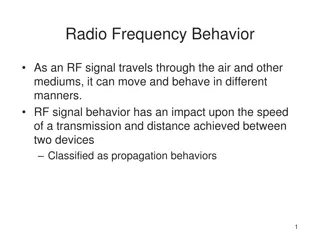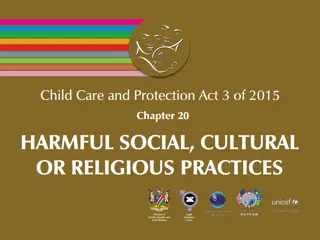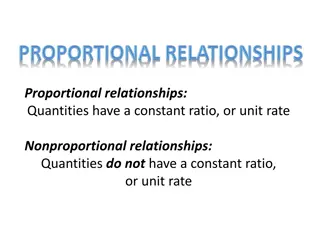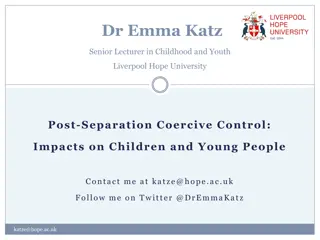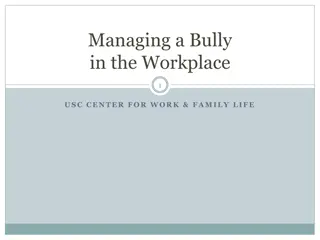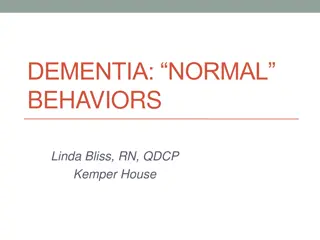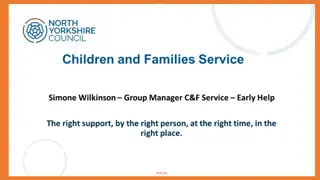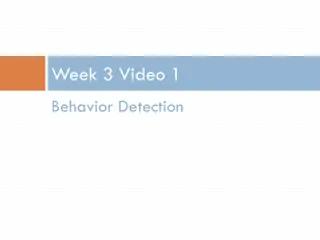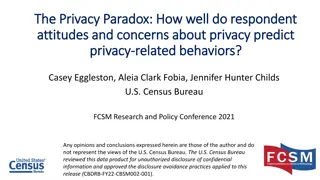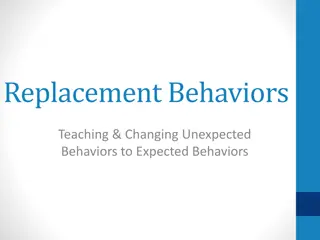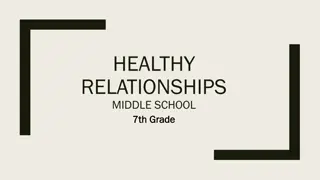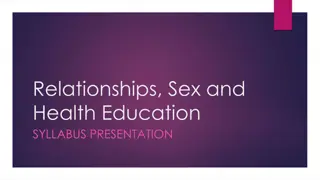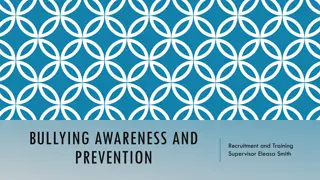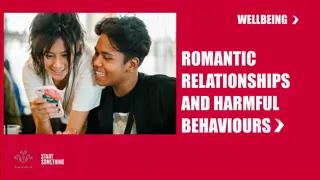Recognizing Harmful Behaviors in Relationships
Learn to identify signs of suicide, understand harmful relationship behaviors, recognize different types of abuse, and distinguish between healthy and dysfunctional family dynamics. Explore vocabulary related to relationship dynamics and self-awareness. Stay informed and promote positive, supportive relationships in your interactions.
Download Presentation

Please find below an Image/Link to download the presentation.
The content on the website is provided AS IS for your information and personal use only. It may not be sold, licensed, or shared on other websites without obtaining consent from the author. Download presentation by click this link. If you encounter any issues during the download, it is possible that the publisher has removed the file from their server.
E N D
Presentation Transcript
Assignments Due: 1. Lesson 13/15 Due TODAY 2. Unit 3 Test Friday, 8/30 Mon August 26, 2019 Today s Agenda: 1. Warm-up 2. SOS Presentation Essential Question: What are the Signs of Suicide? Learning Target: I will be able to recognize signs of suicide in myself or others and know how to get help
A. A condition in which two people depend on each other, yet each has a separate identity B. Violent treatment that results in physical injury to the victim C. Failure to provide proper care and guidance D. Verbally putting down another person E. A problem in which people neglect themselves to try to care for, control, or fix someone else F. A condition in which a person becomes obsessed with the needs of another person and can no longer recognize their own needs G. Sexual contact that is forced on another person H. A family that does NOT promote loving, responsible relationships I. A family that promotes loving, responsible relationships J. A deep and meaningful kind of sharing between two people 1. Neglect 2. Sexual Abuse 3. Physical Abuse 4. Interdependence 5. Healthful Family 6. Codependence 7. Emotional Abuse 8. Dysfunctional family 9. Enmeshment 10. Intimacy Turn in your Lesson 13/15 vocab BEFORE you start your warm Turn in your Lesson 13/15 vocab BEFORE you start your warm- -up up
From the Signs of Suicide video yesterday: 1. Write out what ACT stands for 2. Describe what each step means
Assignments Due: Tue August 27, 2019 1. Crossword Puzzle DUE Block Day 2. Unit 3 Test Friday, 8/30 Today s Agenda: 1. Warm-up 2. Harmful profile notes 3. Marriage notes 4. Unit 3 Crossword Puzzle Essential Question: How can I recognize the harmful ways in which people might behave in a relation ship? Learning Target: I will be able to list and define the 10 harmful profiles.
A brief description of something or someone The following 10 profiles are brief descriptions of how people may relate to others in harmful ways These profiles help you understand ways harmful behaviors can sabotage your chance to have a healthful relationship
A person who constantly seeks the approval of others Do anything to be liked May engage in harmful behavior to fit in or be accepted Described as a doormat Lacks self-confidence Do not demand respect
A person who supports the harmful behavior of others Deny another person s harmful behavior Over look someone s addiction May make up excuses for that person May contribute to their harmful behavior
A person who is needy and dependent Feel empty inside Constantly turns to another person to feel better No amount of attention or affection keeps them feeling fulfilled Very demanding of others The other person usually starts to feel suffocated because they are not given any space
A person who tries to fix other peoples problems Takes on problems that are not their responsibility Quick to give advice They avoid their own problems by fixating on other people s problems
A person who is emotionally unavailable to others May have been hurt in the past Keeps people from getting too close They don t want to risk emotional involvement
A person who is possessive, jealous, and domineering Seeks power Tell the other person what to do and say and wear Does not like to share the object of their affection May lead to violent behavior Act like they own the other person in the relationship
A person who is self-centered Me, me, me They do most of the talking Does not show much interest in others Wants to do what they want, when they want They are not interested in other s opinions
A person who is abusive Cause others harm May threaten, start fights, or act in violent ways Follows abuse with periods of gentleness Abuse behavior returns
A person who does not tell the truth Not honest They lie about themselves to make themselves look good Relationships are based on lies Lack real connection They manipulate others into the responses they want
A person who is not reliable Make plans with someone, then be a no show Makes plans, then breaks them if something better comes along. They may agree to change their behavior, but they don t follow through Never keep their word Lacks sincerity and commitment
What percentage of teen marriages end in divorce?
What percentage of teen marriages end in divorce? 70%
What factors help predict if a marriage will be successful?
1. Age couples that marry in their 20 s or older are more likely to have success Marriage partners that are similar in age also have greater success in marriage
2. Reasons for marriage Couples who marry to love and nurture each other and to share intimacy are more successful than those who marry to escape a difficult situation or to escape loneliness
3. Length of the relationship and engagement Longer relationships provide more opportunity to couples to examine their relationship and develop intimacy
4. Similar attitudes about children and child- raising Couples should discuss this before marriage If and when they want children, how many children do they want how they will raise and discipline their children
5. Similar Interests Opposites attract may not apply Differences may provide extra stressors that must be worked out
6. Commitment to sexual fidelity Physical intimacy provides closeness and security Fidelity establishes trust
7. Good character Make responsible decisions Be aware that their decisions affect your marriage
8. Parents success at marriage People whose parents are divorced are more likely to get divorced themselves They did not live in a family in which parents resolved conflicts
9. Parental attitudes toward the potential marriage partner A marriage is more likely to succeed if a person s parents approve of the future husband or wife
10. Careful selection of the marriage partner A marriage is more likely to succeed when people are cautious when selecting their spouse
Use the key terms from Lessons 13 and 15 the same terms from the vocab worksheet You can work together in your groups When you are done turn it in to the class basket If you do not finish in class, it is HOMEWORK *** 4 Down is NOT on the list of key terms, but was in the notes we took today
Wednesday/ Thursday
If you did not finish your crossword puzzle in class on Tuesday, please turn it in to the class basket BEFORE you start your warm-up 1.A person who is needy and dependant 2.A person who is not reliable 3.A person who is possessive, jealous, and domineering 4.A person who is emotionally unavailable 5.A person who constantly seeks the approval of others 6.A person who is abusive 7.A person who supports the harmful behavior of others 8.A person who does not tell the truth 9.A person who tried to fix other peoples problems 10. A person who is self-centered A. The abuser B. The people pleaser C. The clinger D. The enabler E. The fixer F. The promise breaker G. The center H. The distancer I. The controller J. The liar
Assignments Due: 1. Unit 3 Test THIS FRIDAY Wed/Thu August 29/30, 2018 Today s Agenda: 1. Warm-up 2. Trade and grade Unit 3 Crosswords 3. Pass back graded papers 4. Update binder order 5. Article Summaries in groups 6. Present summaries 7. Unit 3 Review Game Essential Question: What have I learned about Family/Social Health? Learning Target: I will review for the Unit 3 Test on Friday.
D. Unit 2 Test 4 = 29-32 3 = 26-28 2 = 23-25 1 = 20-22 0 = 19 or less
B. Lesson 13/15 Vocab 4 =18-20 3 =16-17 2 =14-15 1 =12-13 0 = 11 or less
1. Read the ENTIRE article as a group 5-8 minutes 2. On the back of this paper, write a summary about the article that your group will present to the class 3. Your summary should start with an introduction discussing what the article was about 4. Your summary should include a minimum of THREE main ideas, with a fact or example for each main idea 5. Your summary should include a conclusion of the article. 6. Your summary should end with a reflection of what your group thought about the article. Whether you liked it or not, or what you found interesting. 7. Your group must then create a visual aid to have up while you present your summary. This could be an outline or bullet points about the article, a graph or chart that summarizes the information, or a picture that is relevant to the article and will help the class understand the information better. 8. Everyone in the group must contribute; everyone will be a part of the presentation. Each person must read a part of the presentation or help with the visual aid.
Marriage Interviews are due in the group basket. Turn them in BEFORE you start your warm Marriage Interviews are due in the group basket. Turn them in BEFORE you start your warm- -up. up. Conflict Enmeshment Interdependence 1.Having high regard for something or someone is __________. 2.____________ is having the feeling of being unwanted or unwelcome. 3.A condition in which a person becomes obsessed with the needs of another person and no longer recognizes his or her own needs. 4.A disagreement between two or more people is a ___________. 5._______________ is a deep and meaningful kind of sharing between two people. 6._____________ is fond feelings a person has toward another person. 7. An attitude of discipline, motivation, and commitment toward tasks is called _____________. 8.A condition in which two people depend on each other, yet each has a separate identity is ______________________. 9.______________ is a problem in which a person neglects themselves and instead wants to fix someone else. 10. The fixed time when a person is supposed to be home is a ___________. Affection Curfew Work Ethic Dating Intimacy Perfectionism Rejection Codependence Respect
Assignments Due: 1. Unit 3 Test - TODAY Fri August 31, 2018 Today s Agenda: 1. Warm-up 2. Unit 3 Test 3. Unit 4 Pretest Essential Question: What I have I learned about Family/Social health? Learning Target: I will assess what I have learned by taking the Unit 3 test
Fill out the top of your bubble sheet Name Class Date Quiz 8/30/19 Unit 3 Test 3rd Hour When you are done with your Unit 3 Test, turn it in and complete the pre-test for Unit 4
Learning Activity A: Pre-test 4 = 10 3 = 8-9 2 6-7 1 = 5 0 = 4 or less



